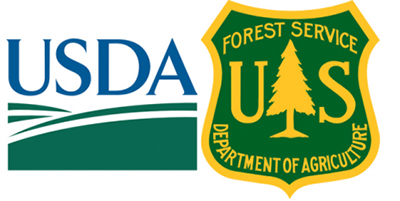
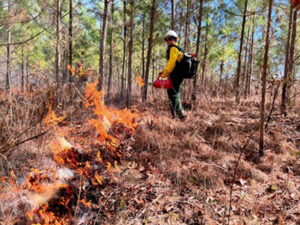
By Sheila Holifield, Southern Region
(Source Forest Services US Department of Agriculture):
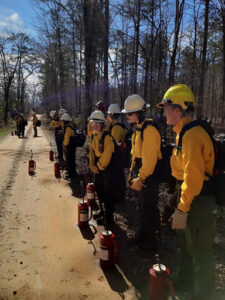
When initiating a prescribed fire, it is important to determine the type of ignition pattern or combination of patterns before the burn. Sam Munson, Student Conservation Association intern and crewmember of the Forest Service’s all-female wildland fire crew, pops out on the road after making an ignitions pass on a 1,000-acre burn on the Tombigbee National Forest in Mississippi. The crew will work and travel throughout the Southern Region, gaining hands-on experience in fire and fuels management work. (USDA Forest Service photo by Megan Saylors).
Southern Region, gaining hands-on experience in fire and fuels management work. (USDA Forest Service photo by Megan Saylors).
On a crisp and cool morning in South Carolina, a team of eight women dressed in yellow Nomex shirts, wearing hard hats and carrying drip torches are preparing to conduct a prescribed burn on the Francis Marion Sumter National Forest. The slow-burning, low-intensity prescribed fire will help protect local communities from wildfire and restore the pine forest to its natural condition.
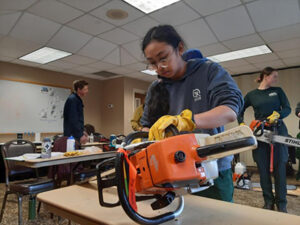
“We are learning how to be students of fire; this means constantly observing the world around us, supporting our team and being open to the ever-present possibility of change,” said Crew Lead Taylor Roe.
The USDA Forest Service recently hired three female fire leaders to mentor interns with the Student Conservation Association, which aims to train the next generation of conservation leaders. The all-female team, called a wildland fire crew, is partnering with the Student Conservation Association, Clemson University, and the Forest Service’s Southern Research Station through funding from the Bipartisan Infrastructure Law.
“Our partnership with the Forest Service has set the crew up to receive critical fire and chain saw qualifications, hands-on experiences, and deep, meaningful connections with current Forest Service employees who also identify as women,” said Toby Bokum-Fauth, vice president of partnership for the Student Conservation Association. “This investment shows a willingness and appetite to support efforts to diversify the Forest Service fire staff for future generations.”
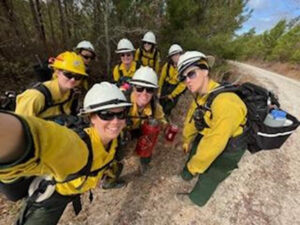
The crew, based out of Clemson, South Carolina, will work and travel throughout the Southern Region gaining hands-on experience in prescribed fire, hazardous fuels reduction and fire suppression alongside the Forest Service firefighters.
“The program carves out a specific space for women to train, work and learn about wildland fire together within the different ecosystems in the Appalachia, Piedmont, and Coastal Plain regions,” said Megan Saylors, crew superintendent with the Forest Service.
In fire management, every bit of training is essential. It’s the path to the certifications needed to move up in rank and pay, and a key risk management tool that keeps these crews safe in a high-risk environment.
Saylors brings a unique perspective to the all-female crew. Her job with the Forest Service is an Interagency Hotshot Crew Squad Leader on the Deschutes National Forest in central Oregon. Throughout her fire experience she has seen firsthand the disparity among the fire workforce.
The Forest Service’s fire workforce in early 2022 was 87% male and 13% female. This program provides participants with direct experience with the Forest Service. The goal is to encourage more women to join the next generation of fire management leaders and practitioners.
“This is a safe space where I can learn, make mistakes, and explore new parts of myself that I didn’t even realize I had within me. Each day is new,” said crew member Greta Ketchner.
This all-female wildland fire crew is a key part of the Student Conservation Association’s commitment to guiding new and increasingly diverse generations toward conservation careers as it’s never been more important or relevant to the communities we serve, said Bokum-Fauth.
The Student Conservation Association and the Forest Service are exploring a second cohort beginning in Jan. 2024.


Be the first to comment